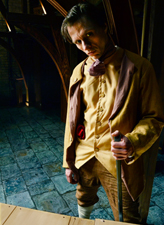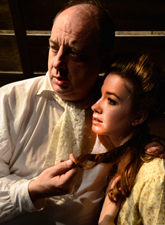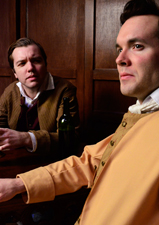From the Chicago Reader
February 24, 2014
By Albert Williams
RECOMMENDED
Charles Dickens’s 1859 novel, set during the Reign of Terror that followed the 1789 French Revolution, comes to the stage in a taut, suspenseful adaptation that captures the romantic idealism, dark humor, and social outrage that drive this ripping good yarn. Playwright Christopher M. Walsh and director Elise Kauzlaric hone in on the core of Dickens’s sprawling story: the triangular relationship between a young Frenchwoman (daughter of a former political prisoner) and the two men who love her (a dissolute English lawyer and a French aristocrat trying to atone for his family’s misdeeds). Designers Joe Schermoly (set) and Diane D. Fairchild (lights) have created a stylized minimalist environment that keeps the tale’s frequent changes in locale clear, and the ten-member ensemble delivers intense, compelling performances. Particularly good are John Henry Roberts as the narrator; Carolyn Klein as the fierce, vengeful revolutionary Madame Defarge; and Josh Hambrock as Sydney Carton, the feckless Englishman who is redeemed by his self-sacrifice.
From Stage and Cinema
France Trims Its 1% With The Guillotine
February 24, 2014
By Lawrence Bommer
2014 has been as good to 1859 as it was to the late 18th century. Christopher M. Walsh’s adaptation of Charles Dickens’ novel — a saga of unexpected heroism during the French Revolution — is Lifeline Theatre latest page-to-stage triumph. Dickens put faces to history, and in 150 minutes Walsh’s new version “rereads” the work into stirring action. Thanks to John Henry Roberts as the “Resurrection Man” narrator, Walsh also adds an acerbic point of view. (The R.M. sees folly on both sides: Our sole redemption is, it seems, our peculiar preference for “our better angels” — as Lincoln said at the same time — over our worser instincts.)
No crude condensation mars Lifeline’s supple restoration: Its current swiftly propels the citizens of two cities into crises and confrontations between 1775 to 1790. Coherent as it makes the sprawling story of a feckless lawyer’s ultimate sacrifice for the woman he loved but lost, this Tale of Two Cities also drives home Dickens’ sharply-detailed contrast of the best and worst of times: More than the English channel separates the Parisians, divided between a mob mentality and a fascist aristocracy, and Londoners, comparative moderates who pluckily work to secure justice beyond Dr. Manette’s release from the Bastille.
That good doctor must return to the scene of the crime to save an innocent man from the busy tumbrels that lead to an overachieving guillotine. But in Dickens’ love triangle there are two more innocent men. Charles Darnay may have repudiated his lineage to the Marquis St. Evremonde, cruelest of the ancient regime’s malevolent masters, but, nonetheless, this fiancé of lovely Lucy, daughter of the doctor, finds himself imprisoned by the implacable Defarges and the Revolutionary Tribunal. His one hope lies in the man who defended him years before, Sydney Carton, the self-deprecating, drunken wastrel of an attorney. But Sydney’s one stake in life or claim to the future is his hopeless adoration of Lucy, the love of his life who gave herself to the rival that Sydney must save. By story’s end this strange savior has found a new way to stake that claim. It’s one of the great renunciation scenes in 19th century literature.
Happily, Elise Kauzlaric’s staging is as driven as the plot. As the at times rather matter-of-fact Lucie Manette, Maggie Scrantom rises to the occasion as devotion confers courage. Playing the persecuted and brain-broken Dr. Manette, “called to life” after 18 years in the Bastille, Sean Sinitski delivers the pathos of a promising physician imprisoned for knowing too much about the hateful Evremondes. Carolyn Klein breathes hell and damnation as Madame Defarge, her well-deserved demise as satisfactory as it ever felt on the page. Deserving merit finds its natural home in Nicholas Bailey’s stalwart Charles Darnay, who bears a necessary resemblance to the semi-suicidal Sydney — an interpretation that is not always the case in stage and film adaptations of this work. In the complicated role of a survivor who discovers a greater glory (“a far, far better thing” indeed), Josh Hambrock restores Sydney’s self-respect, with nothing becoming his life so much as how he leaves it.
Kauzlaric leaves nothing to chance, crafting stirring support from Katie McLean Hainsworth as Miss Pross, the feisty and very British governess, Chris Hainsworth as a predatory patrician and unscrupulous spy, and Dean Granata as Monsieur Defarge, a henpecked radical who should overthrow his wife as much as Louis XVI. Roberts’ sardonic narrator weaves it together as seamlessly as Mme. Defarge does her dangerous knitting.
Has Dickens imagined the future as much as the past? At first Occupy Wall Street seemed to be more than just a blast from the past. But no Bastille has fallen: We’re left with a realm as divided as anything France endured 225 years ago.
From Examiner.com
Lifeline brings A Tale of Two Cities to life
March 16, 2014
By Janet Arvia
FOUR STARS
For more than 30 seasons, Lifeline Theatre has created its niche as a company that launches original adaptations of literary classics. Continuing this tradition is its world premiere production of A Tale of Two Cities.
Unlike most of Charles Dickens’s novels which are set in Victorian England, A Tale of Two Cities takes place in London and Paris during the Reign of Terror. It’s a story that deals with dualities as stated in the opening line, “It was the best of times, it was the worst of times.” Juxtaposed behavior unfolds as persecuted French peasants turn into brutal oppressors and a British barrister who spends his life as a drunken cynic greets death in such a magnanimous way, he becomes one of literature’s most revered (and law-breaking) heroes.
All this (and more) is conveyed in Christopher M. Walsh’s tight adaptation. Despite a deliberate start, the play picks up speed and suspense with a climactic close prior to intermission. The second half successfully delivers plot pay-offs via character coincidences that tie together in one big Dickensian bow, ending with the work’s prophetic and poetic line, “It is a far, far better thing that I do, than I have ever done; it is a far, far better rest that I go to than I have ever known.”
More than 150 years have passed since A Tale of Two Cities first appeared in 31 monthly installments yet its political observations, dramatic action, comical comments, and romantic sacrifices remain fresh thanks to the collective performances by Josh Hambrock as Sydney Carton and ensemble members Katie McLean Hainsworth and Chris Hainsworth.
Maggie Scrantom adds depth to Lucie Manette, John Henry Roberts shows versatility as the Resurrection Man, and Carolyn Klein makes a convincing Madame Defarge. Rounding out the solid cast are Sean Sinitski as Doctor Manette, Nicholas Bailey as Charles Darnay, Melissa Engle as the Seamstress, and Dan Granata as Monsieur Defarge.
Under the skillful direction of Elise Kauzlaric and technical direction of Scenic Designer Joe Schermoly, A Tale of Two Cities makes good on Lifeline’s mission to stage sprawling stories in an intimate space.
From Time Out Chicago
February 26, 2014
By Suzanne Scanlon
“It was the best of times, it was the worst of times, it was the age of wisdom, it was the age of foolishness, it was the epoch of belief, it was the epoch of incredulity, it was the season of Light, it was the season of Darkness, it was the spring of hope, it was the winter of despair…” So begins the Resurrection Man (John Henry Roberts) as our eloquent narrator for Lifeline Theatre’s production of Charles Dickens’s A Tale of Two Cities. Adapted for the stage by Lifeline’s Christopher M. Walsh, and directed by Elise Kauzlaric, the production foregrounds not just Dickens’s belletristic prose, but a sentence-level parallelism reflecting the doubling of protagonists: the depressed Englishman, Carton (Josh Hambrock), and the elegant, gentle Frenchman Darnay (Nicholas Bailey).
Their relationship does much to drive the plot, leading us to the moments that feel most alive. Kauzlaric’s staging of the end of Act I has the fuming patriots ready to storm the Bastille; with less of Hugo’s notorious miserables, these revolutionaries are rabid, menacing. The second act ends with even more electricity, as our hero faces the guillotine, and, he trusts, the mercy of his Christian god.
Some of the Dickensian plot convolutions, together with multiple underdeveloped characters, feel less worthwhile on stage than they might on the page. Still, the actors are uniformly strong: Darnay and Carton (whose rousing, elegiac final speech sends goosebumps) play their doubles with alacrity, and others (including Maggie Scrantom as Lucie Manette and Sean Sinitski as Doctor Manette) bring even the less detailed characters to resonant life. Though inconsistently rendered, in the moments where the power of Dickens’s text meets the power of theatrical craft, this Tale is something to behold.
From Windy City Times
March 5, 2014
By Mary Shen Barnidge
A man who doesn’t think that he deserves love can never be loved by others — and therein lies the paradox of tragic romantic heroes in literature from Cyrano de Bergerac to the present day. What distinguishes the two suitors to Miss Lucie Manette in the love triangle that anchors Charles Dickens’ novel is that Charles Darnay declares his affection and then asks the lady to marry him, while Sydney Carton, after confessing same, expresses relief that his devotion is certain to be unreturned. What’s a girl to say to that?
This is not Jane Austen’s England, however, where such domestic tangles are quickly resolved, but a nation menaced by global unrest preceding cataclysmic social upheaval, both across the channel in allied France and across the Atlantic in its U.S. colonies, during an era still fresh in the memories of Dickens’ readers. French expatriates like Darnay and Lucie’s own father cannot escape their connections with a country embroiled in near-anarchy, leaving their salvation in the hands of heroic British sympathizers, bred of upright societies where masters and servants share a united moral accord.
Christopher M. Walsh’s adaptation facilitates the multiple dimensions of his epic narrative through the introduction of a protean Everyman, dubbed “The Resurrection Man” (euphemism for a “corpse-snatcher”), to play all of the commoners, and to act as our guide to the volatile world of coups d’état. His commentary allows Walsh to focus on the intrigue associated with a Parisian merchant family’s revenge upon the estranged Darnay’s aristocratic ancestors — a vendetta that will endanger him and those he loves, while exacting terrible risks in unexpected quarters.
Fitting big stories into small spaces is Lifeline Theatre’s specialty, its stage’s restrictive floor dimensions and high ceilings easily accommodating 10 actors portraying citizens on two continents ( with the assistance of Elise Kauzlaric’s dialect instruction and Andrew Hansen’s audio score that replicates the descent of the guillotine blade with chilling accuracy ). John Henry Roberts deftly keeps us apprised of his diverse personae with never a trace of disruptive jocularity, his unswerving focus matched by an ensemble capable of riveting our attention for the swift-paced two-and-a-half hours necessary before the villains are dispatched, the innocent rescued and the noble rewarded for their sacrifice.
From Chicago Theatre Review
A Dickensian Delight at Lifeline Theatre
March 7, 2014
By Lazlo Collins
Highly Recommended
“Lifeline Theatre’s ‘A Tale of Two Cities’ is a suspenseful and emotional journey to the past. A winning (Christopher M Walsh) adaptation of this classic story is brought to a rich life… This Lifeline production takes the heart of the story and treats it lovingly and with respect. Its simple story telling and terrific acting make this a great production. The direction by Elise Kauzlaric makes some beautiful images throughout this satisfying adaptation. The casting is perfect. Not a weak link in the group… From the opening moments to the closing heart wrenching moments, it is pure Dickens; but with a swiftness and light. This classic should not be missed.”
From chicagocritic.com
Sprawling novel effectively comes to life at Lifeline Theatre
February 26, 2014
By Tom Williams
RECOMMENDED
Adapter Christopher M. Walsh skillfully reduced Charles Dickens’ sprawling 1859 novel into a fine stage production now playing at Lifeline Theatre. They specialize in mounting terrific stage versions of novels. Their A Tale of Two Cites, directed by Elise Kauzlaric, continues the fine work of bringing classic novels to life on stage.
A Tale of Two Cities is set in Paris and London in 1775 during The Reign of Terror that swept through Paris that ignited the French Revolution that led to the downfall of the French aristocracy. We meet victims of both the aristocracy and the revolutionaries as many suffered the guillotine as social and political change swept France.
We meet Monsieur Defarge (Dan Granata) and his wife Madame Defarge (Carolyn Klein) — two fledgling revolutionaries as they aide Doctor Manette (Sean Sinitski) — a victim of 18 years imprisonment by the King by reuniting him with his daughter Lucie (Maggie Scrantom). Together with Miss Pross, (Katie Hainsworth) Luce’s governess, the three migrate to London to start a new life in freedom.
Also leaving Paris for London is the heir to the estate of the Marquis St. Evremonde, now known as Charles Darney (Nicholas Bailey) after he leaves the estate in the hands of his butler (John Henry Roberts). Once in London, Darney meets and falls in love with Lucie Manette after she helps him win a court case from anti-government charges leveled against him. Darney’s lawyer, Sydney Carlton (Josh Hambrock) also falls for Lucie as the two look-alike men court the lovely Lucie.
As life becomes pleasant for the Manette’s, Darney and somewhat for Carlton, The Reign of Terror rages on in Paris. Darney receives a letter from the servant who is running his former estate in France informing him that said servant is impressed by the Citizens now in power in France. He is charged with capital offenses that could lead to the guillotine. Darney feels duty bound to return to France to defend his former servant despite the risk of retuning since former aristocrats are no longer welcome in France. But Darney, after marrying Lucie, returns to Paris but is arrested after being betrayed. The Manette’s followed Darnay once they learn that he has been arrested.
Things get complicated as the Defarge’s now have power to convict or release Darney. I’ll not say more so as not spoil the plot twists that Walsh’s adaptation so nicely presents. The violent social upheaval is vividly presented. The lawyer Carton, suffering from depression and the loss of Lucie’s hand, decides to make his life mean something by going to Paris to help Darnay. His self-sacrifice is the embodiment of redemption and sacrifice. He emerges as the true noble person. His unrequited love for Lucie requires his actions.
Despite a slow pace early on, A Tale of Two Cities eventually grabs us and keeps us engaged until the strong second act becomes a powerful one. using the thick accents, some actors speak too fast thus rendering their speeches hard to understand. Once the players slow down a tad, this production will improve . There is enough craft from the game cast of tn to make Lifeline Theatre’s production of the Dicken’s classic worth seeing. Josh Hainsworth and Nicholas Bailey were particularly effective with John Henry Roberts’ lively narration the glue that holds the show together.

























